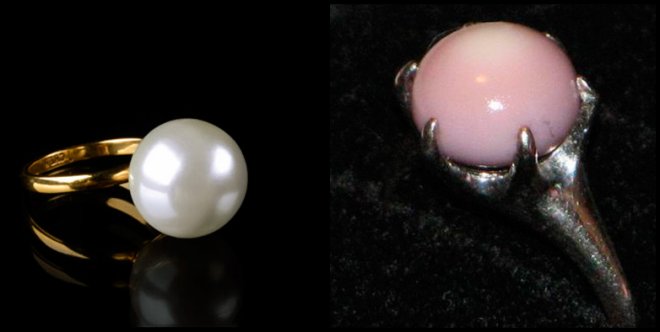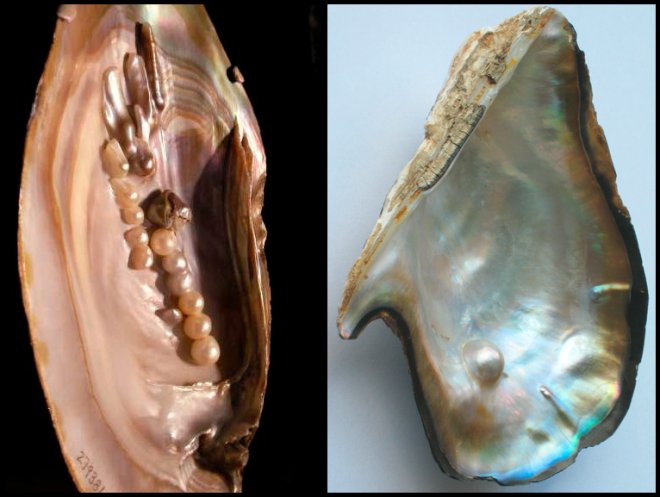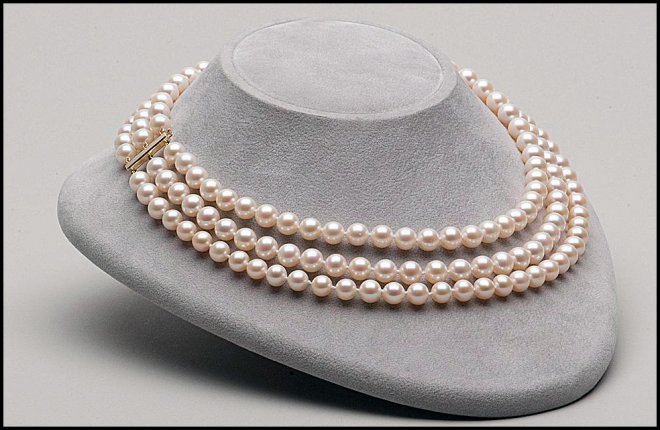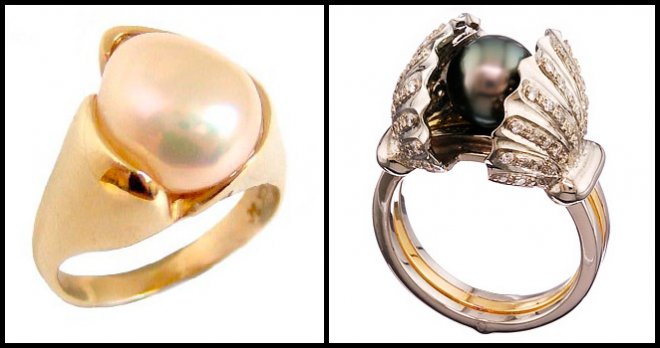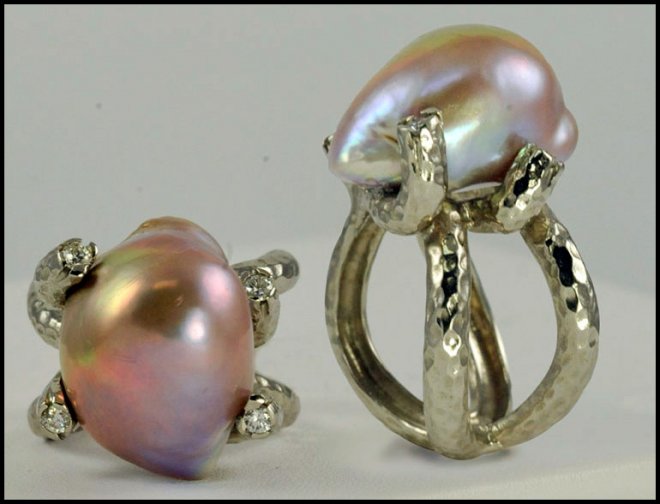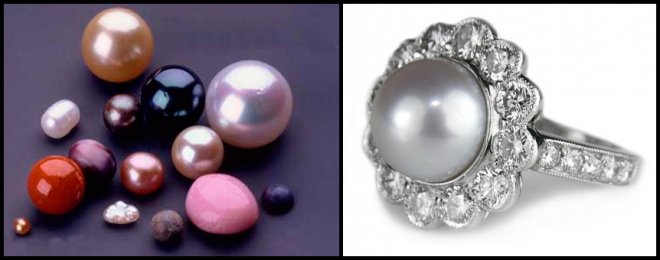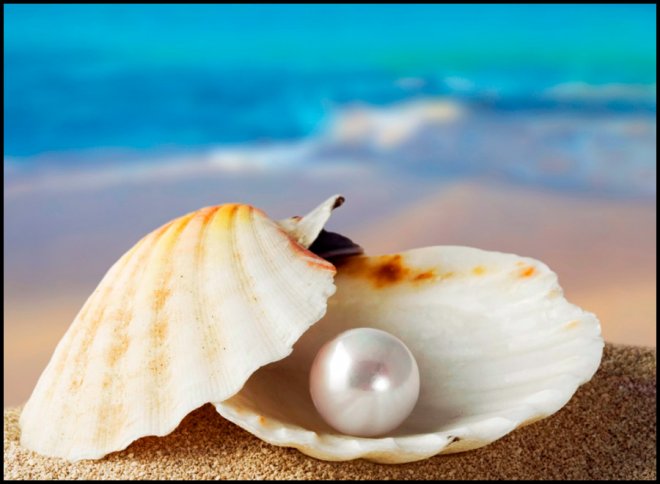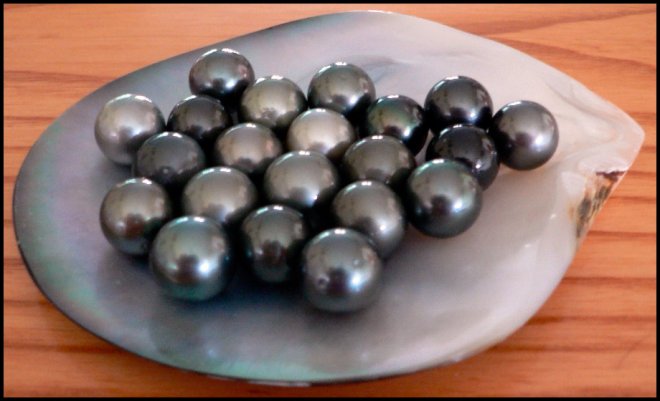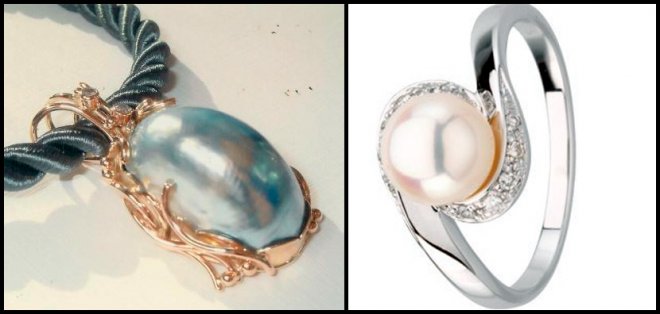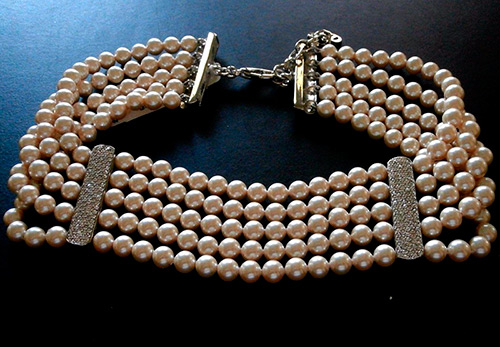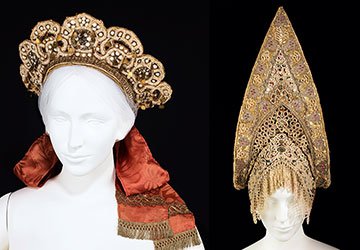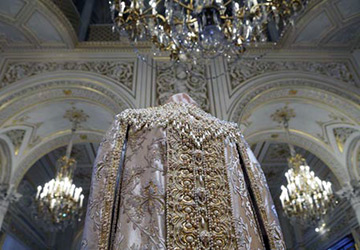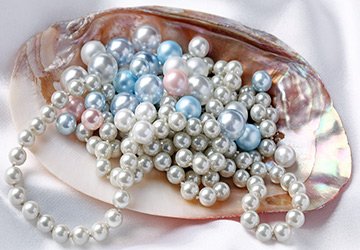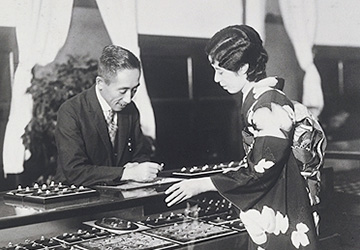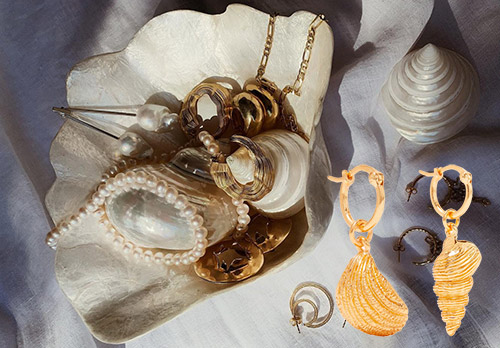Jewelry
“... Pearls that rested for a long time, -
The tears that the naiads shed ... "
Walter Scott
“... And the bright tears that you dropped,
They will return, turning into pearls ... "
William Shakespeare
Natural pearls and their origin.
Pearls are tears, so it was thought from the 1st century BC. NS. and up to the fifteenth century A.D. Poetry, with its sound and elegant description of beauty, is designed to delight our ears, and is addressed to the senses. In ancient times, and in the Middle Ages, people completely trusted the author's poetic fantasy. The mystery of the origin of pearls gave romantic coloring not only legends, but also influenced science. Many believed that pearls were created from drops of rain or dew. Moreover, the researchers of those years adhered to this theory. In 1761, the Swedish naturalist K. Linnaeus managed to obtain pearls and prove that their formation occurs from the invasion of a foreign body into the soft tissues of a mollusk.
Natural pearls do not require processing, he is beautiful in his own guise.
Natural pearls are one of the noblest materials, which have always been used to decorate items of particular importance: altars, priests' vestments, bindings of manuscripts, crowns and other valuable regalia. In both Christian and Islamic religions, pearls are considered a symbol of purity and perfection. The oldest pearl necklace is kept in Paris in the Persian gallery of the Louvre. This jewel consists of three strands, on which 216 pearls are strung. During the Roman Empire, pearls were many times more expensive than in the modern era. Roman emperors adorned their clothes with pearls. At the beginning of the twentieth century, a string of pearls was considered the most luxurious jewelry on a par with other precious stones. These necklaces were very expensive, the price went up to 300 thousand. dollars, and not many could afford.
The word pearl (pearl), it is believed, was formed from the Latin pirula - grain, or "pernula" - sea shell, but the Greeks, and then the Romans in relation to pearls used the word - margarita.
Fishing areas for pearls. When they say "oriental" pearls, they mean pearls obtained from oysters off the coast of India, Sri Lanka, in the Persian Gulf, in the Red Sea. Pearls were also supplied from the Pacific coast of Mexico, Australia and America. And now these are the main marine fishing areas. There are freshwater pearls (from the rivers of Scotland, France, Ireland, America, Lake Biwa - Japan).
Chemical composition of natural pearls: calcium carbonate (in the form of aragonite) - up to 90%, organic conchiolin and water. Conchilion is concentrated either in the form of a layer near the surface or in the center of the pearl, which affects its color. The quality of the shine depends on the texture of the layers of mother-of-pearl (aragonite) overlapping each other. The configuration and size of these plates and the reflection of light by them give subtle nuances of color and brilliance. Pearls are white, yellow, blue, pink, red, black.
One of the important physical parameters is the density, which determines the difference between natural and cultured pearls. Pearls from the Persian Gulf have a density of 2.71, from the waters of Australia - 2.78. High-quality natural pearls are quite rare, which is why such pearls are among the noblest ones. jewels.
The healing properties of pearls.
They say that pearls have medicinal properties - they were credited with the gift of relief from hypertension, from diseases of the kidneys, stomach, liver, intestines, as well as the property of an indicator of human health.Some studies have concluded that pearls that are exposed to sweat glands (sweat is acidic) and cosmeticsdim. Of course, it is impossible to say unequivocally whether a person is sick or healthy, since all people have different skin reactions, but you may need to pay attention. In ancient times, street vendors invited people to buy pearls, which have lost their appeal, for "medical" purposes. Gullible people thought pearls were useful for stimulating sexual activity, as their merchants assured. But, turning to the chemical composition, we see that its main content is calcium carbonate. Therefore, if pearls help in anything, it is as a laxative. But, most likely, in order to get rid of such a disease, each of us will hurry to the pharmacy and buy phytolax or senade, and leave the pearl necklace for himself for decoration.
HOW TO CHOOSE A NATURAL PEARL
The choice for many is often determined by the cost of pearls, and the following qualities affect the cost:
The size. Everything is clear here - if the pearl is large, then its cost is higher. Such pearls are rare, since its birth is due to various circumstances, which includes the life cycle of mollusks and the dangers that lie in wait for them, as well as the rarity and episodic occurrence of foreign particles entering the mollusk.
Smoothness of the surface. Of course, this quality primarily affects the price of pearls. If there are no irregularities, cracks, dark spots, or pimples on the surface of the pearl, then this is a good pearl.
The form. Round pearls are one of the most expensive. It's easy to check its roundness - take a pearl and roll it on a flat and smooth surface. If it rolls straight, then the surface is round. Perfectly round pearls are rare, therefore, their price is higher. In the form of a drop or pear - this is also a rarity, it belongs to symmetrical shapes. The sharper the symmetry about the center of the axis, the higher the price. Among pearl aficionados, the drop shape is highly prized. There is also an asymmetrical shape, but the price for such pearls is also high. What's the matter? It depends on the beauty of the form, as in this case, designers can show their imagination and apply the original form to create an exclusive piece of jewelry.
Colour. It has already been said about the color of pearls. But what color is the most popular - it depends on preference, on the perception of beauty and imagination of designers and buyers. Different colors of pearls are formed by different oysters and depend on their location. For example, pink pearls are formed in oysters of the Persian or Manara Gulf and are distinguished by perfect brilliance, the best varieties of black pearls came from the Tuamoto (Pearl Islands) archipelago, located in the Pacific Ocean, golden pearls from Shark Bay on the West Coast of Australia. Here you can enumerate and enumerate endlessly, since natural pearls come in many shades of different colors. To see an admixture of a different color, the pearl should be viewed away from direct rays of light. And looking at it in direct light, you can see several other shades. The cost depends on the beauty and popularity of the color.
Shine. Everything is simple here. The more luster, the higher the value of the pearl.
Pearls of a spherical shape and beautiful color are on a par with diamonds, emeralds, rubies. You can always see diamonds on the windows of first-class jewelers, but a flawless natural pearl is a rarity. Rarity is another inherent quality in pearls. Everything that has been said above refers to natural pearls.
Cultured pearls. In Japan, there is a cemetery for Japanese pearl seekers who died precisely because of the hard work in search of pearls.Dates on the graves go back to the distant past ... Representing this difficult and dangerous, or, more simply, slave labor, one of the best films of Soviet cinema - "The Amphibian Man", which shows the amazing beauty of the sea, the surrounding nature, wonderful music, involuntarily comes to mind , great actors and a sad song about those who have gone forever to the sea: "... it is better to lie at the bottom, in the fresh cool darkness, than to suffer on the harsh, cruel, cursed land ...". It is difficult to find pearls given by nature, but their beauty and durability attracts many - the demand for pearls has increased, and natural reserves have decreased. That is why somewhere at the end of the eighteenth - at the beginning of the nineteenth centuries. remembered the method of Carl Linnaeus - the method of growing pearls. First of all, it is necessary to create all conditions for the survival of oysters, for example, protection from storms, strong currents, sufficient depth, the nature of the seabed, the level of salinity of the water, which greatly affects the color of pearls, the constancy of the water temperature and ... How laborious and requires great patience process , and it is not possible to speak.
Japanese experts have achieved and continue to achieve excellent results in introducing embryo beads into the body of the mollusk. The coloring of such pearls is achieved not with the help of dyes, but by introducing a piece of mantle epithelium taken from a certain area of another mollusc into the body of the mollusk. Operations are complex and require high perfection of the master in this matter. For example, in the past, to obtain black cultured pearls, the cultured pearls were first dyed by immersing them in silver nitrate. Now they get naturally colored cultured black pearls by growing them with the help of black-lipped oysters that live near the island of Tahiti. In fact, natural black pearls are very rare.
In the jewelry market, cultured pearls are in increasing demand, since they are a natural product and the principle of their formation is the same as that of natural ones. And the cost of these pearls is on par with natural ones. In 1990, a strand of cultured pearls, consisting of large pearls, was sold at auction for 2 million. 200 thousand dollars. Pearls are grown not only in Japan, but also in Australia, Burma, on about. Tahiti, Philippines, home to large oysters.
The longevity of natural pearls is related to its structure, which is a superposition of thin microscopic layers of aragonite. Such a structure is an obstacle when exposed to pressure. The symmetrical structure of the pearls makes it easy to drill. When a master works with natural pearls, he feels how the drill moves smoothly; when drilling cultured pearls, the drill jerks, as if it is jammed. This is also related to its structure. At the same time, rhythmic bounces when the pearl hits the surface confirm not only its high resonance properties, but also the fact that the pearl is of natural origin (a cultured pearl does not bounce in this way).
How is the mass of pearls measured?
The unit of mass for pearls is grain. A grain is a quarter of a metric carat or 0.0648 grams.
How to wear pearl jewelry.
Natural pearls and natural and cultured pearls should be worn carefully, cleaned regularly, protected from fire, acids, solvents and disinfectants. Doesn't like pearls and cosmetics... The necklaces should be touched occasionally to prevent the beads from sticking to each other. Sometimes it is better to thread it again, tying knots between the beads. This is done so that there is no friction between them. The knots will prevent the pearls from slipping off the string if it suddenly breaks. Pearls, including cultured ones, should not be wrapped in a cotton-woolen cloth, as the heat generated by it causes the pearls to dry out. Many gemstones change color when exposed to heat.Do not wash with disinfectants or store with other jewelry (scratches may occur due to rubbing with other jewelry). Sometimes pearls can be kept wrapped in a slightly damp linen cloth to prevent them from drying out. Should not be stored in a corduroy case or near appliances that generate heat.
To date, the largest pearl is known, weighing 450 carats, which is kept in the Geological Museum in South Kensington in London.
This is the history and origin of beautiful pearls. I tried to bring that information about pearls that will awaken in you not only the desire to have this jewel, but also a feeling of gratitude to nature and the people who create this miracle.
Comments and Reviews
Add a comment
Rating news
Shades of clothing that make women look younger
What shades of hair make women younger: rules and photos
Funny wedding dresses - photos and ideas
12 most expensive down jackets for the winter
How to look 25 at 40: tips from supermodels
Beautiful schoolgirls
Anti-aging haircuts and hairstyles for women
Fashionable skirts for autumn and winter
Fashionable women's trousers for the cold season
Fashionable and stylish sandals for summer 2024
Spring-summer 2024
 Fashionable dresses and tops with thin spaghetti straps
Fashionable dresses and tops with thin spaghetti straps
 Bandana tops: how to wear stylishly and beautifully
Bandana tops: how to wear stylishly and beautifully
 How to put together the perfect men's wardrobe for the summer
How to put together the perfect men's wardrobe for the summer
 Fashionable shorts for spring-summer 2024
Fashionable shorts for spring-summer 2024
 Fashionable skirts for spring-summer 2024: a guide to online shopping
Fashionable skirts for spring-summer 2024: a guide to online shopping
 The most fashionable dresses spring-summer 2024: styles and colors
The most fashionable dresses spring-summer 2024: styles and colors
 Fashionable total look 2024: ideas of images and trends
Fashionable total look 2024: ideas of images and trends
